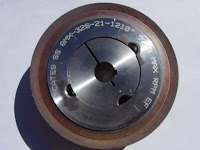We all know that tension is important, and measuring tension with a gauge is a great way to prevent belt drive problems. However, there are a few options out there, and sometimes people are confused as to what they need.
Two of the lower cost options that Gates offers for tension testers are the Pencil Type Gauge, and the Krikit Gauge. Both of these are easy to use tools that allow the user to measure tension in the belt, and compare it to recommended tensions, but they function a little differently.
The Krikit gauge is generally seen as an automotive gauge used on front end accessory drives for cars and trucks. The way this gauge works is by depressing the finger pad on the gauge with the bottom of the gauge against the belt. The belt will deflect downward and push the arm of the Krikit up across a scale on the top of the gauge. At a certain amount of force applied to the finger pad, the Krikit will ‘click’. When the user hears the click, pressure should be released, and you can read the amount of tension in the belt by looking at where the front of the arm crosses the scale.
The Pencil gauge is generally seen as an industrial gauge, and uses two o-rings and a spring. You place the big end of the gauge on the belt, and set the bottom o-ring to the recommended deflection distance. You will need a straight edge, piece of string, or a mark on the wall next to the belt to determine starting height of the back of the belt. Set the plunger o-ring to zero, and push down on the plunger until the bottom o-ring meets the reference point you set for the starting height of the back of the belt. At this point, release the pressure on the plunger, and read the force recorded by the movement of the plunger o-ring. This is the value that you will want to compare to the recommended tension values for your drive.
As described above, there are obvious differences in how the gauges function, but the one thing that may not be obvious is the tensions that they are reading. The Krikit measures tension ‘in’ the belt, while the pencil gauge measures deflection force at a certain distance. This is important to note because different sources will recommend tension differently, either direct tension that the belt is seeing (the tension in the belt), or as a matter of deflection force and deflection distance.
Both of these tools are offered in several capacities for measuring tension, and both work very well, but they work in two different ways. It’s important to know which way your tension measurement is being given so that you can select the proper tool.



